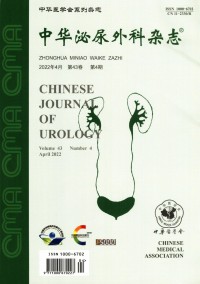Feasibility study of modified RUSS to predict the stone free rate after flexible ureteroscopic lithotripsy
Q4 Medicine
引用次数: 0
Abstract
Objective To explore the feasibility of the modified RUSS (Resorlu-Unsal Stone Score) renal stone scoring system in predicting the stone free rate after Flexible Ureteroscopic Lithotripsy(FURL). Methods Retrospective analysis was performed on 104 cases of renal stones treated by FURL from March 2017 to January 2019 in the second affiliated hospital of zhengzhou university, including 75 males and 29 females. Age 20-75 (47.79±13.21) years. BMI 18.2-38.3 (24.4±3.7) kg/m2; Crushed stone site: left 56 cases, right 48 cases. There were 23 cases of renal inferior calyces calculi, 81 cases of non-inferior calyces calculi, and 19 cases of renal inferior calyces calculi with IPA<45°; American Society of Anesthesiology (ASA) scores: 65 cases of grade Ⅰ, 39 cases of grade Ⅱ; There were 71 patients with urinary tract infection before operation. There were 6 cases of renal puncture fistula before operation. Preoperative indwelling ureteral stent in 26 cases; There were 32 cases with history of extracorporeal shock wave lithotripsy. There were 27 patients with a history of urolithiasis therapy. The same physician used preoperative urinary CT+ 3D reconstruction imaging data to measure the factors influencing the postoperative stone free rate. RUSS renal stone scoring system was used to score the stones of patients before operation, and the relationship between the scores and the stones free rate was analyzed. The RUSS renal stone scoring system was supplemented and improved by including staghorn stone, duplicate renal, caliceal diverticulum, renal malrotation, stone area, and CT value related indexes. The modified RUSS renal stone scoring system was used to score the preoperative stone condition of patients, and the relationship between the score and the stone free rate was analyzed. The receiver operating characteristic curve (ROC) was drawn and the area under the curve (AUC) was calculated to compare the advantages and disadvantages of the modified RUSS, the characteristics of the stones, and RUSS system. Results The stone free rate was 69.2% (72/104) 4 weeks after the operation, and there were no postoperative complications. Single-factor analysis showed that stone area, CT value, number of renal calyx involved by stone, multiple stones, IPA, stone size grading, renal anatomic structure abnormality, staghorn stone were all related risk factors affecting postoperative patients. Multi-factor analysis showed that stone area, number of renal calyces involved by stone, multiple stones, IPA and stone size were independent risk factors affecting the stone free rate after FURL. RUSS scores ranged from 0 to 3 points, corresponding to stone clearing rates of 86.8% (33/38), 67.7% (23/34), 58.3% (14/24) and 25.0% (2/8), respectively. Stone clearing rates were significantly correlated with stone grading (P<0.05). The total scores of stone free group and residual stone group were (0.87±0.96) points and (1.53±0.98) points, respectively, with significant differences between the groups (P<0.05). The range of modified RUSS score was 0-4 points, corresponding to the stone clearing rate of 100.0% (25/25), 92.3% (24/26), 54.2% (13/24), 47.4% (9/19), and 10.0% (1/10), respectively. Stone free rate was significantly correlated with stone grading (P<0.05). The total scores of stone free group and residual stone group were (1.15±1.13) points and (2.81±0.93) points, respectively, with significant differences between the groups (P<0.05). The AUC of stone features was smaller than that of the modified RUSS scoring system. The AUC of RUSS scoring system (0.707, 95%CI 0.598-0.815) was smaller than that of the modified RUSS scoring system (0.865, 95%CI 0.797-0.933). Conclusions Both the RUSS scoring system and the modified RUSS scoring system could accurately predict the postoperative stone free status of FURL, while the modified RUSS scoring was more accurate than the RUSS scoring. Key words: Ureteroscopes; Renal stone scoring system; Flexible ureteroscopic lithotripsy; Stone free rate; Influencing factors改良RUSS预测输尿管镜碎石术后结石游离率的可行性研究
目的探讨改良RUSS(Resorlu Unsal Stone Score)肾结石评分系统预测柔性输尿管镜碎石术后结石清除率的可行性。方法对郑州大学附属第二医院2017年3月至2019年1月收治的104例肾结石患者进行回顾性分析,其中男性75例,女性29例。年龄20-75岁(47.79±13.21)。BMI 18.2-38.3(24.4±3.7)kg/m2;碎石部位:左侧56例,右侧48例。IPA<45°的肾下盏结石23例,非下盏结石81例,肾下盏19例;美国麻醉学学会(ASA)评分:Ⅰ级65例,Ⅱ级39例;术前尿路感染71例。术前肾穿刺瘘6例。术前留置输尿管支架26例;32例有体外冲击波碎石术史。有27名患者有尿石症治疗史。同一位医生使用术前尿液CT+3D重建成像数据来测量影响术后结石清除率的因素。采用RUSS肾结石评分系统对患者术前结石进行评分,分析评分与结石清除率的关系。RUSS肾结石评分系统通过包括鹿角石、重复肾、杯状憩室、肾旋转不良、结石面积和CT值相关指标进行了补充和改进。采用改良的RUSS肾结石评分系统对患者术前结石情况进行评分,并分析评分与结石清除率的关系。绘制受试者工作特性曲线(ROC)并计算曲线下面积(AUC),以比较改良RUSS的优缺点、结石的特性和RUSS系统。结果术后4周结石清除率为69.2%(72/104),无并发症发生。单因素分析显示,结石面积、CT值、结石累及肾盏数、多发结石、IPA、结石大小分级、肾脏解剖结构异常、鹿角形结石均为影响术后患者的相关危险因素。多因素分析表明,结石面积、结石累及肾盏数、多发结石、IPA和结石大小是影响FURL术后结石清除率的独立危险因素。RUSS评分范围为0至3分,结石清除率分别为86.8%(33/38)、67.7%(23/34)、58.3%(14/24)和25.0%(2/8)。结石清除率与结石分级显著相关(P<0.05)。无结石组和残石组总分分别为(0.87±0.96)分和(1.53±0.98)分,两组间差异有统计学意义(P<0.05),改良RUSS评分范围为0-4分,对应结石清除率分别为100.0%(25/25)、92.3%(24/26),分别为54.2%(13/24)、47.4%(9/19)和10.0%(1/10)。无结石率与结石分级显著相关(P<0.05)。无结石组和残余结石组的总分分别为(1.15±1.13)分和(2.81±0.93)分,两组之间存在显著差异(P<0.05),结石特征的AUC小于改良的RUSS评分系统。RUSS评分系统的AUC(0.707,95%CI 0.598-0.815)小于改良的RUSS评分体系(0.865,95%CI 0.797-0.933)。关键词:输尿管镜;肾结石评分系统;弹性输尿管镜碎石术;石材免费率;影响因素
本文章由计算机程序翻译,如有差异,请以英文原文为准。
求助全文
约1分钟内获得全文
求助全文
来源期刊

中华泌尿外科杂志
Medicine-Nephrology
CiteScore
0.10
自引率
0.00%
发文量
14180
期刊介绍:
Chinese Journal of Urology (monthly) was founded in 1980. It is a publicly issued academic journal supervised by the China Association for Science and Technology and sponsored by the Chinese Medical Association. It mainly publishes original research papers, reviews and comments in this field. This journal mainly reports on the latest scientific research results and clinical diagnosis and treatment experience in the professional field of urology at home and abroad, as well as basic theoretical research results closely related to clinical practice.
The journal has columns such as treatises, abstracts of treatises, experimental studies, case reports, experience exchanges, reviews, reviews, lectures, etc.
Chinese Journal of Urology has been included in well-known databases such as Peking University Journal (Chinese Journal of Humanities and Social Sciences), CSCD Chinese Science Citation Database Source Journal (including extended version), and also included in American Chemical Abstracts (CA). The journal has been rated as a quality journal by the Association for Science and Technology and as an excellent journal by the Chinese Medical Association.
 求助内容:
求助内容: 应助结果提醒方式:
应助结果提醒方式:


